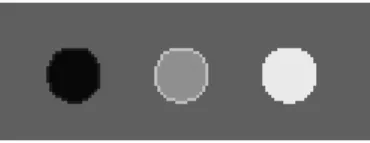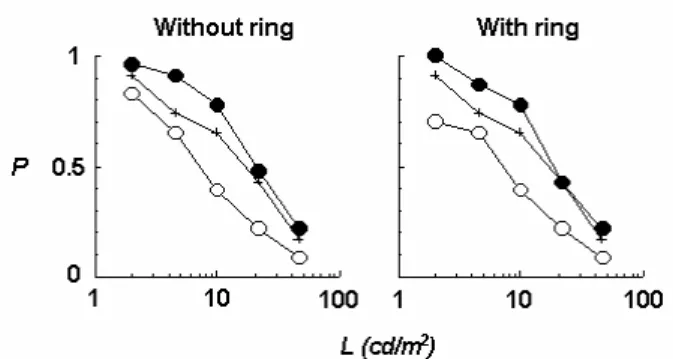4 5 4 5 4 5 4 5 4 5
VIÉS DE RESPOSTA NO AGRUPAMENTO
Sergio Cesare Masin,
Università degli Studi di Padova, Itália
Resumo: A similaridade da cor da superfície pode causar um agrupamento perceptual de superfícies acromáticas uniformes sobre um fundo acromático tanto quando o fundo é homogêneo e quando o fundo contém superfícies de contexto acromáticas. Os resultados empíricos aqui relatados demonstram que a res-posta de agrupamento devido à similaridade em cor da superfície de teste é afetada também pelas superfícies de contexto. Foi proposto que este viés da resposta resulta da interferência da resposta de agrupamento causa-da pela similaricausa-dade em cor causa-da superfície de teste com uma resposta de agrupamento implícita causacausa-da pela similaridade em cor entre superfícies de contexto e as superfícies de teste.
Palavras-chave: Agrupamento perceptual, similaridade acromática de cor, efeitos de contexto, viés de resposta
RESPONSE BIAS IN GROUPING
Abstract: Surface color similarity may cause the perceptual grouping of uniform achromatic surfaces on an achromatic background both when the background is homogeneous and when the background contains achromatic context surfaces. Empirical results reported here show that the grouping response due to the similarity in color of test surfaces is also affected by context surfaces. It is proposed that this response bias results from interference of the grouping response caused by the similarity in color of test surfaces with an implicit grouping response caused by the similarity in color between context surfaces and test surfaces.
Key-words: Perceptual grouping, achromatic color similarity, context effects, response bias
Artigo recebido para publicação em 08/09/2003; aceito em 28/11/2003. Endereço para correspondência: Sergio C. Masin, Dipartimento di Psi-cologia Generale, Via Venezia 8, 35131-Padova, Itália
E-mail: scm@unipd.it
Typically, grouping of surfaces is studied using test surfaces placed on a uniform background. For example, the test disks in Figure 1 are placed on a uniform gray background. The central test disk groups more probably with the right test disk because the achromatic colors of these disks are more simi-lar (Beck, Graham, & Sutter, 1991; Masin, 2002; Oyama, Simizu, & Tozawa, 1991).
Figure 1. Example of achromatic surface grouping. The central and right disks group more probably because their colors are more similar.
In everyday situations, however, grouping occurs often on backgrounds with context surfaces. Figure 2 provides two examples of a context surface using copies of the three test disks shown in Figure 1: the central test disk is on a black context square in Figure 2a and is on a white context square in Figure 2b.
46
present study was designed to test these possibilities, using test disks as stimuli.
Three disks on a uniform background (Figu-re 1) we(Figu-re used as base-line test disks. These disks with a square under the central disk (Figure 2) were also used to explore the effect of context surfaces on the grouping response.
Finally, three disks in patterns as those in Figure 3 were used to explore the separate effects of lightness induction and of alteration of perceived contrast caused by the context square. Each pattern in Figure 3 is a reproduction of the respective pattern in Figure 2 with a ring whose inner border coincides with the border of the central test disk and whose luminance is equal to the luminance of the background. The effect of lightness induction could be tested separately from that of the alteration of perceived contrast because, in stimuli as those shown in Figures 1 and 3, the luminance contrast of central test disks with equal luminance was independent of the context square.
Method
Participants. 23 students of the University of Padua with normal or corrected-to-normal vision participated.
Stimuli. In a dark room, each stimulus appeared in the middle of a frontal parallel 33 x 25cm achromatic screen of an Apple monitor controlled Figure 2. Reproductions of the three test disks shown in Figure 1: (a) with a black context square and (b) with a white context square.
(a) (b)
Figure 3. Reproduction of Figure 2 with two rings concentric with the central test disks. The luminances of the rings and of the background are equal.
(a) (b)
by a Macintosh 7200 computer. The viewing distance was about 1m.
Stimuli were three achromatic 18mm wide disks whose centers were spaced 60mm apart horizontally. Stimuli appeared with no context surface, as in Figure 1, or with a 60 x 60mm context square concentric with the central disk, as in Figure 2, or with this square with a ring whose inner border coincided with the border of the central disk, as in Figure 3. The width of the ring was 6mm.
In all stimuli, the luminances for the left and right disks were 1 and 100cd/m2, respectively, and the luminance for the ring and the background was 15cd/m2. There were five sets of five stimuli. In one of these sets, stimuli had no context square, in another they had a black context square without the ring, in another they had a white context square without the ring, in another they had a black context square with the ring, and in the fifth set they had a white context square with the ring. In each set, the luminances for the black and white squares were 1 and 100cd/m2, respectively, and the luminance of the central disk was 2, 4.5, 10, 21.5, or 46cd/m2.
Stimulus duration was 3 sec. Stimuli subsequent to the first stimulus appeared 1 sec after the experimenter typed the participant’s response.
Procedure. A square matrix of 81 small circles was first shown on the screen. Two perceptual groups were exemplified by changing the shade of some contiguous columns of this matrix. Subsequently, the stimulus was verbally described to the participant using a drawing of the outlines of stimulus parts. The participant had to focus on the center of each stimulus as soon as the stimulus appeared and to report verbally whether the central test disk grouped with the left or with the right test disk. The series of 25 stimuli was shown once with stimuli in random order.
Results
Figure 4 shows the proportion P of the reports that the central test disk grouped with the left (black) test disk as a function of the luminance L of the cen-tral test disk. The horizontal axis is logarithmic. In the left diagram, the filled and unfilled circles refer to stimuli with the context square without the ring
4 7 4 7 4 7 4 7 4 7
and in the right diagram, they refer to stimuli with the context square with the ring. Filled and open circles show the results for stimuli with the black and with the white context squares, respectively. Crosses show the results for stimuli with no context square. These crosses are represented in both diagrams to facilitate comparison.
A 2 (ring: stimuli with context square without ring vs. stimuli with context square with ring) x 2 (color of context square: black vs. white) x 5 (luminance of central test disk) analysis of variance showed that the effect of ring was not significant [F(1, 22) = .32] while the effect of color of context square was significant [F(1, 22) = 12.95, p < .005]. All interactions [ring by color of context square, F(1, 22) = .09; ring by luminance of central test disk, F(4, 88) = .08; color of context square by luminance of central test disk, F(4, 88) = 1.40; ring by color of context square by luminance of central test disk, F(4, 88) = .39] were not significant.
Ps from stimuli with no square did not differ statistically from the corresponding Ps from stimuli with the black context square without the ring [F(1, 22) = 2.84] nor from the corresponding Ps from stimuli with the black context square with the ring [F(1, 22) = 2.31], while they differed statistically both from the corresponding Ps from stimuli with the white context square without the ring [F(1, 22) = 4.57, p < .05] and from the corresponding Ps from stimuli with the white context square with the ring [F(1, 22) = 4.87, p < .05].
Discussion
The results reported in Figure 4 show that the effect of context square on P was independent of the ring and, consequently, was independent of the Figure 4. Proportion P of reports that the central test disk grouped with the left (black) test disk, in stimuli as those in shown in Figures 1-3, as a function of the luminance L of the central test disk. Filled circles, open circles, and crosses show the results for stimuli with the black context square, with the white context squares, and with no context square, respectively.
luminance contrast along the contour of the central test disk.
Had lightness induction been the only effect of context squares, the results reported in Figure 4 would have been the opposite of what they are. That is, since the white context square made the central test disk darker, Ps from stimuli with the white context square (open circles) should have been higher, rather than being lower, than the corresponding Ps from stimuli with no square (crosses) and, since the black context square made the central test disk lighter, Ps from stimuli with the black context square (filled circles) should have been lower than (rather than being statistically equal to) the corresponding Ps from stimuli with no square (crosses).
These results show that context squares had an effect on the grouping response that was neither due to lightness induction nor to the luminance contrast of the central test disk. I offer the following explanation in terms of response bias of this new effect of context surfaces on grouping.
It could be that the similarity in color between the context square and one of the lateral (left or right) test disks elicited an implicit grouping response, and that this response interfered with the overt grouping response elicited by the similarity in color of the cen-tral test disk with the lateral test disks. For example, with reference to either Figure 2 or 3, the black square would tend to group with the black (left) test disk and thus would prime the response “grouping with the left test disk”, or the white square would tend to group with the white (right) test disk and would thus prime the response “grouping with the right test disk”. The priming of one of these responses would make the corresponding overt response to the grouping of test disks more probable at the moment when the participant decides which of these disks forms a group.
References
Beck, J., Graham, N., & Sutter, A. (1991). Lightness differences and perceived segregation of regions and populations. Perception & Psychophysics, 49, 257-269.
48
Heinemann, E.G. (1955). Simultaneous brightness induction as a function of inducing- and test-field luminances. Journal of Experimental Psychology, 50, 89-96.
Masin, S.C. (2002). Absolute and relative effects of similarity and distance on grouping. Perception, 31, 799–811.
Masin, S.C. (2003). Effects of algebraic and absolute luminance differences on achromatic surface grouping. Perception, 32, 615–620.
Oyama, T., Simizu, M., & Tozawa, J. (1991). Effects of similarity on apparent motion and perceptual grouping. Perception, 28, 739-748.


